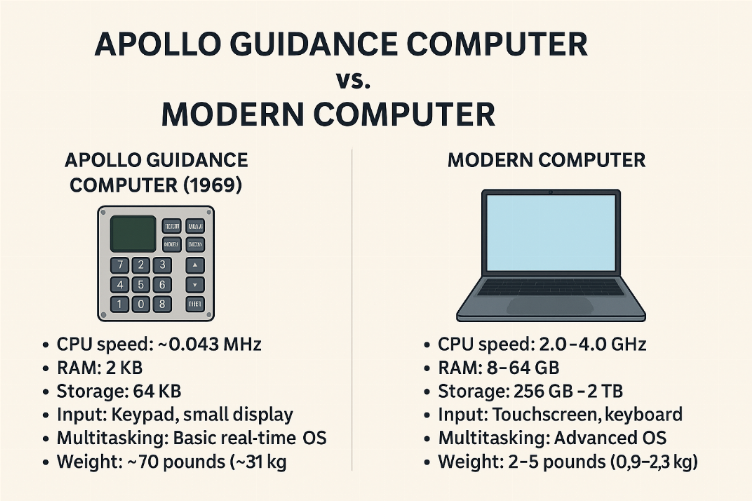Apollo Guidance Computer vs. Modern Computers: What’s the Real Difference?
In 1969, NASA sent astronauts to the Moon using a spacecraft controlled by a computer with less power than today’s cheapest digital watch. The Apollo Guidance Computer (AGC), used in the Apollo missions, was a technological marvel of its time—but how does it hold up compared to the smartphones and laptops we carry today?
The AGC: Minimal Power, Maximum Reliability
The Apollo Guidance Computer was custom-built to control navigation and flight operations for the Command Module and Lunar Module. It had:
-
CPU speed: ~0.043 MHz (43,000 Hz)
-
RAM: Just 2 KB
-
ROM (Program memory): 64 KB
-
Storage: No hard drive, only read-only core rope memory
-
Input: A keypad and display system called DSKY (Display & Keyboard)
-
Multitasking: Basic real-time operating system
-
Weight: ~70 pounds (31 kg)
Despite its low specs by today’s standards, the AGC was incredibly reliable and could run multiple tasks, detect system overloads, and recover from errors—crucial in a mission where lives depended on flawless execution.
Today’s Computers: Power and Versatility
Now compare that to a modern smartphone or laptop:
-
CPU speed: 2–4 GHz (over 1 million times faster)
-
RAM: 4–64 GB
-
Storage: 128 GB to several terabytes
-
Input: Touchscreen, keyboard, microphone, cameras, sensors
-
Multitasking: Advanced operating systems like iOS, Android, Windows, or macOS
-
Weight: Less than 1 lb for a phone, 2–5 lbs for a laptop
Smartphones today can play high-definition video, run real-time AI, connect across the globe, and manage thousands of simultaneous processes—things unthinkable in 1969.
Why It Worked Anyway
The AGC didn’t need to browse the web or run dozens of apps. It needed to calculate spacecraft position, control engine burns, and assist in manual lunar landing. It was built to be small, durable, radiation-resistant, and above all, trustworthy.
The software was written in assembly language, tightly optimized, and even included safeguards like priority-based task handling—long before such features became standard.
A Legacy of Ingenuity
So, was the Apollo computer “good enough”? Absolutely. It did what no computer had ever done: help send humans to another celestial body and bring them home safely.
The comparison shows how far we’ve come in raw computing power—but also how advanced the Apollo engineers were in creating technology that could do so much with so little.
It’s a powerful reminder that the future of innovation isn’t just about power—it’s about purpose-driven design.
